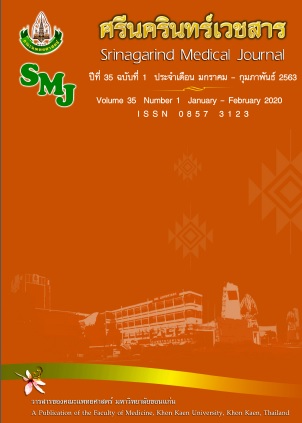Test-retest reliability of body center of mass sway during Five Time Sit to Stand Test; FTSST assessed by Kinect-Based Exergames device in healthy elderly
Keywords:
Reliability, FTSST, Body Center of Mass (COM) sway, Elderly, KinectAbstract
Background and Objective: The main factor of fall risk prevention in elderly is fall risk assessment; FRA. Therefore, reliable assessment method is very important. The purpose of this study was to define the test-retest reliability of body center of mass (COM) sway assessment while perform sit to stand using Kinect-Based Exergames device in older adults.
Methods: Twenty older adults aged more than 60 years (mean age was 67.30 ± 5.58 years) were instructed to performed Five Time Sit to Stand Test (FTSST) while the body COM sway in 3 directions were evaluated by Kinect and software which was developed. The participants were assessed two trials with 1-week resting period. The Intraclass correlation coefficients (ICC3,1) was used to explore test-retest reliability and significant levels were set at p < 0.05.
Results: The results showed that test-retest reliability of body COM sway during FTSST was good reliability (ICC3,1 were between 0.83 – 0.90).
Conclusion: The kinematics assessment of body COM sway during FTSST which were evaluated by Kinect and software which was developed is test-retest reliable assessment.
References
Cho KH, Bok SK, Kim YJ, Hwang SL. Effect of lower limb strength on falls and balance of the elderly. Ann Rehabil Med 2012; 36: 386-93.
Biderman A, Cwikel J, Fried AV, Galinsky D. Depression and falls among community dwelling elderly people: a search for common risk factors. J Epidemiol Community Health 2002; 56: 631.
Karlsson MK, Vonschewelov T, Karlsson C, Coster M, Rosengen BE. Prevention of falls in the elderly: a review. Scand J Public Health 2013; 41: 442-54.
Pozaic T, Lindemann U, Grebe A-K, Stork W. Sit-to-Stand Transition Reveals Acute Fall Risk in Activities of Daily Living. IEEE J Transl Eng Health Med 2016; 4: 2700211.
Brooks D, Davis AM, Naglie G. Validity of 3 physical performance measures in inpatient geriatric rehabilitation. Arch Phys Med Rehabil 2006; 87: 105-10.
Riddle DL, Stratford PW. Interpreting validity indexes for diagnostic tests: an illustration using the Berg balance test. Phys Ther 1999; 79: 939-48.
Shumway-Cook A, Baldwin M, Polissar NL, Gruber W. Predicting the probability for falls in community-dwelling older adults. Phys Ther 1997; 77: 812-9.
Whitney SL, Wrisley DM, Marchetti GF, Gee MA, Redfern MS, Furman JM. Clinical measurement of sit-to-stand performance in people with balance disorders: validity of data for the Five-Times-Sit-to-Stand Test. Phys Ther 2005; 85: 1034-45.
Nardone A, Schieppati M. The role of instrumental assessment of balance in clinical decision making. Eur J Phys Rehabil Med 2010; 46: 221-37.
Visser JE, Carpenter MG, van der Kooij H, Bloem BR. The clinical utility of posturography. Clin Neurophysiol 2008; 119: 2424-36.
Peterson Silveira R, Stergiou P, Carpes FP, Castro FA, Katz L, Stefanyshyn DJ. Validity of a portable force platform for assessing biomechanical parameters in three different tasks. Sports Biomech 2017; 16: 177-86.
Crawford S. How Microsoft Kinect Works 2011 [Cite March 17, 2019]. Available from: http://electronics.howstuffworks.com/microsoft-kinect.htm.
Mentiplay BF, Perraton LG, Bower KJ, Pua YH, McGaw R, Heywood S, et al. Gait assessment using the Microsoft Xbox One Kinect: Concurrent validity and inter-day reliability of spatiotemporal and kinematic variables. J Biomech 2015; 48: 2166-70.
Winter DA. Biomechanics of Human Movement. Biomechanics 1979:65-83.
de Leva P. Adjustments to Zatsiorsky-Seluyanov's segment inertia parameters. J Biomech 1996; 29: 1223-30.
Yamada T, Demura S. Influence of the relative difference in chair seat height according to different lower thigh length on floor reaction force and lower-limb strength during sit-to-stand movement. J Physiol Anthropol Appl Human Sci 2004; 23: 197-203.
Kaewkaen K, Uttama S, Ruengsirarak W, Kaewkaen P. Test-retest Reliability of the Five Times Sit-to-Stand Test measured using the kinect in older adults. J Assoc Med Sci 2019; 52: 138-44.
Lord SR, Murray SM, Chapman K, Munro B, Tiedemann A. Sit-to-stand performance depends on sensation, speed, balance, and psychological status in addition to strength in older people. J Gerontol A Biol Sci Med Sci 2002; 57: M539-43.
Clark RA, Pua YH, Oliveira CC, Bower KJ, Thilarajah S, McGaw R, et al. Reliability and concurrent validity of the Microsoft Xbox One Kinect for assessment of standing balance and postural control. Gait Posture 2015; 42: 210-3.
Kejonen P, Kauranen K. Reliability and Validity of Standing Balance Measurements with a Motion Analysis System. Physiotherapy 2002; 88: 25-32.
Downloads
Published
How to Cite
Issue
Section
License
Copyright (c) 2020 Srinagarind Medical Journal

This work is licensed under a Creative Commons Attribution-NonCommercial-NoDerivatives 4.0 International License.




